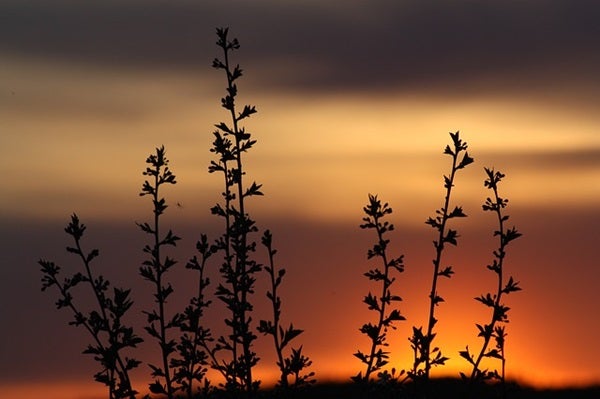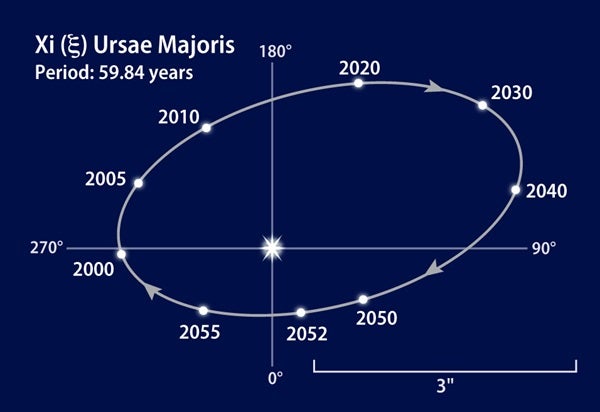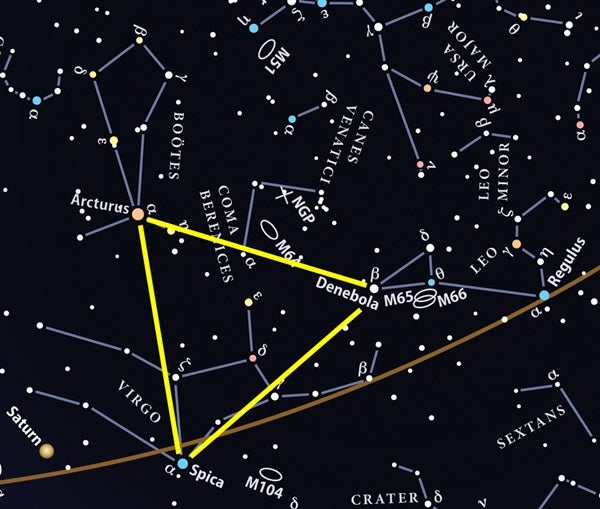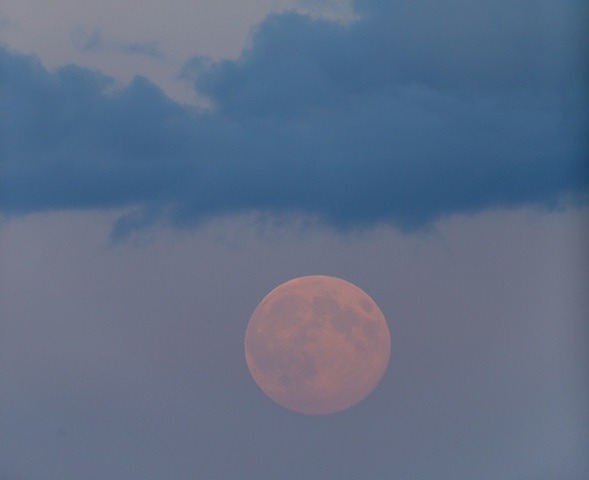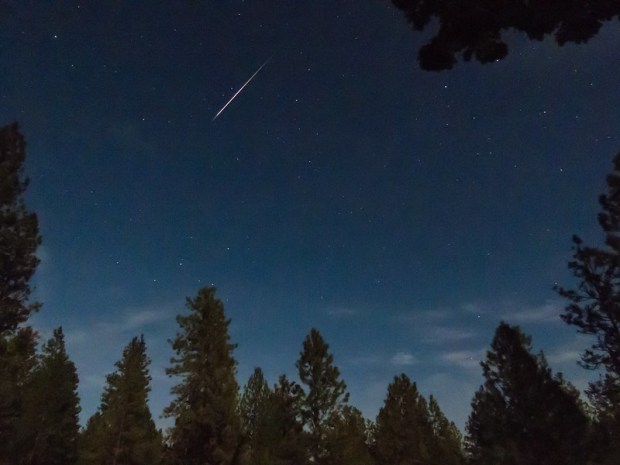Friday, March 19
At this time of year, stepping outside after dark and looking high overhead in the northwest will net you the bright star Capella in the constellation Auriga the Charioteer. Capella is a yellow-white star (actually a binary, but its components are challenging to separate) whose name means “she-goat.” Just south of the star is a small, three-star asterism called The Kids; one of these stars is Epsilon (ϵ) Aurigae.
Auriga houses several deep-sky gems, including three Messier open clusters (for those still working on their Messier marathons — more on that tomorrow!). M38 is a faint cluster that lies about halfway between Al Kab and Bogardus (Iota [ι] and Theta [θ] Aurigae); binoculars may pick it up, and a small scope certainly will. M36 is just over 2° northeast of Chi (χ) Aurigae. Smaller than M38, its light is more condensed and may be easier to see. Finally, you’ll find M37 nearly 5° south-southwest of Theta, just one binocular field east of M36. The brightest stars in this cluster are around magnitude 9, so its light is a bit misty but discernible from the background if you take your time.
Sunrise: 7:05 A.M.
Sunset: 7:12 P.M.
Moonrise: 10:19 A.M.
Moonset: 12:25 A.M.
Moon Phase: Waxing crescent (33%)
*Times for sunrise, sunset, moonrise, and moonset are given in local time from 40° N 90° W. The Moon’s illumination is given at 12 P.M. local time from the same location.
Saturday, March 20
The vernal equinox occurs at 5:37 A.M. EDT this morning. On the equinox, the Sun sits exactly above Earth’s equator; this date also marks the beginning of spring in the Northern Hemisphere.
If you weren’t able to get in on the Messier marathon excitement last weekend, don’t worry — this weekend is your next best chance to run the race. The waxing Moon will present slightly more of a challenge when finding fainter objects early on, but the early morning hours of the 21st will be Moon-free and darker as you near the finish line.
And if you don’t want to search out Messier’s full catalog yourself, let the staff at Lowell Observatory in Flagstaff, Arizona, do it for you! The observatory is hosting a virtual star party beginning at 6:45 P.M. PST tonight and running overnight, ending just before sunrise in Flagstaff at 6:15 A.M. PST on Sunday. The event, which will be recorded in Lowell’s Giovale Open Deck Observatory, will be livestreamed simultaneously on YouTube and Twitch, or you can watch it below.
Sunrise: 7:03 A.M.
Sunset: 7:13 P.M.
Moonrise: 10:57 A.M.
Moonset: 1:25 A.M.
Moon Phase: Waxing crescent (42%)
Sunday, March 21
First Quarter Moon occurs at 10:40 A.M. EDT.
Although our satellite is quickly growing brighter night by night and washing out deep-sky objects, bright stars remain easy to spot and fun to observe. One such star is Alula Australis — a rapidly moving binary star system in Ursa Major the Great Bear. Also known as Xi (ξ) Ursae Majoris, the pair was first identified as a physically related duo (i.e., not just a visual pair) by William Herschel in 1780. (Stay tuned — Herschel will also feature later this week.) Nearly 50 years later, Xi became the first binary to have its orbit determined, thanks to French astronomer Felix Savary.
Xi’s orbital period is about 60 years. That may seem long, but it still means the pair moves noticeably over the years. Amateur observers have long delighted in drawing the pair, then returning years later to see what change has wrought.
First, find Xi by looking 1.3° south of Alula Borealis (Nu [ν] Ursae Majoris), often drawn as the Bear’s back foot. Through a telescope, you can split magnitude 3.8 Xi into a magnitude 4.3 primary and a magnitude 4.8 companion. Once you’ve found them, take a photo or make a sketch of the stars’ locations. Keep this safe — it will be your roadmap when you next return to see how much they’ve moved.
Sunrise: 7:01 A.M.
Sunset: 7:14 P.M.
Moonrise: 11:41 AM
Moonset: 2:22 A.M.
Moon Phase: Waxing gibbous (51%)
Monday, March 22
Mars passes 7° north of Aldebaran at 8 P.M. EDT. Don’t confuse the magnitude 1 planet for the red giant star, which is slightly fainter at magnitude 0.8 and much closer to the Hyades open star cluster sprinkled across the Bull’s nose.
To their west is the Pleiades (M45) open cluster, which can look a little like a tiny dipper on the sky — in this case, not to be confused with the Little Dipper asterism, which is much larger and circles the North Celestial Pole, with the North Star Polaris at the end of its handle. The Pleiades is a gorgeous naked-eye sight, with at least six or seven bright stars visible to most observers; eagle-eyed individuals may count a few more. This famous cluster is also emblazoned on the back of every Subaru vehicle, as the brand name is also the cluster’s Japanese name.
Sunrise: 7:00 A.M.
Sunset: 7:15 P.M.
Moonrise: 12:32 P.M.
Moonset: 3:18 A.M.
Moon Phase: Waxing gibbous (61%)
Tuesday, March 23
Asterisms are unofficial patterns of stars not recognized as one of the 88 official constellations. One of the most famous is the Summer Triangle — but did you know there’s a Spring Triangle, too?
The Spring Triangle comprises magnitude –0.04 Arcturus (Alpha [α] Boötis) in Boötes, magnitude 1 Spica in Virgo (Alpha Virginis), and magnitude 2.1 Denebola (Beta [β] Leonis) in Leo the Lion. Although the Triangle is visible all night during the spring in the Northern Hemisphere, the season is still young and Spica — the last of the three to rise — currently clears the horizon shortly before 11 P.M. local time. Once you’ve found this asterism, however, keep returning to it once a week or so to determine how its visibility changes, as Spica rises ever earlier as spring progresses.
Sunrise: 6:58 A.M.
Sunset: 7:16 P.M.
Moonrise: 1:31 P.M.
Moonset: 4:08 A.M.
Moon Phase: Waxing gibbous (70%)
Wednesday, March 24
This month marks 240 years since William Herschel’s official discovery of Uranus. Tonight, you can try finding the magnitude 6 ice giant for yourself once full darkness falls. Look west to locate the Pleiades (M45), then drop down about 21.5° to spot the planet. Because it is low on the horizon and a bright, waxing Moon is in the sky, its barely naked-eye brightness might be overwhelmed — instead, use binoculars or a small scope to see it.
Uranus’ disk currently spans 3″ and will appear as a “flat” gray star through your eyepiece. It sets a few hours after sunset, so look earlier rather than later for the best views.
If you miss Uranus, Mars is still nearby, now located 12° east of the Pleiades and 7.3° north-northeast of Aldebaran.
Sunrise: 6:56 A.M.
Sunset: 7:17 P.M.
Moonrise: 2:36 P.M.
Moonset: 4:52 A.M.
Moon Phase: Waxing gibbous (79%)
Thursday, March 25
As soon as Jupiter rises high enough to view from your location this morning, you’ll want to train your telescope on the giant planet, where two of its moons are keeping things exciting. Around 6:25 A.M. EDT, you’ll see Ganymede already in front of the gas giant’s eastern limb. But keep watching — minutes later, Io will pop out from behind the planet, also to its east.
As dawn brightens the sky, Ganymede continues across the disk as Io pulls farther away. Zoom out a bit and you’ll see Europa just over 2′ to Jupiter’s east, while Callisto sits nearly 3′ to the planet’s west. See how long you can follow Ganymede’s journey with the rising Sun quickly approaching.
Sunrise: 6:55 A.M.
Sunset: 7:18 P.M.
Moonrise: 3:46 P.M.
Moonset: 5:32 A.M.
Moon Phase: Waxing gibbous (87%)
Friday, March 26
Venus is in superior conjunction at 3 A.M. EDT. Although it rises with the Sun and isn’t visible, several other planets are lined up for you to enjoy early this morning. An hour before sunrise, Saturn and Jupiter have cleared the horizon amid the stars of Capricornus. Saturn is higher (12°) but fainter (magnitude 0.6) than Jupiter (7°), which is magnitude –2.
Just 30 minutes before sunrise, Mercury — located in Aquarius — has cleared the horizon. It’s bright at magnitude –0.2 but difficult to make out in the growing twilight. The tiny planet sits just over 23° east of Jupiter; if you choose to find it with binoculars or a telescope, make sure to put your optics away several minutes before sunrise to avoid causing unintended damage to your eyes.
Sunrise: 6:53 A.M.
Sunset: 7:19 P.M.
Moonrise: 4:58 P.M.
Moonset: 6:06 A.M.
Moon Phase: Waxing gibbous (94%)

